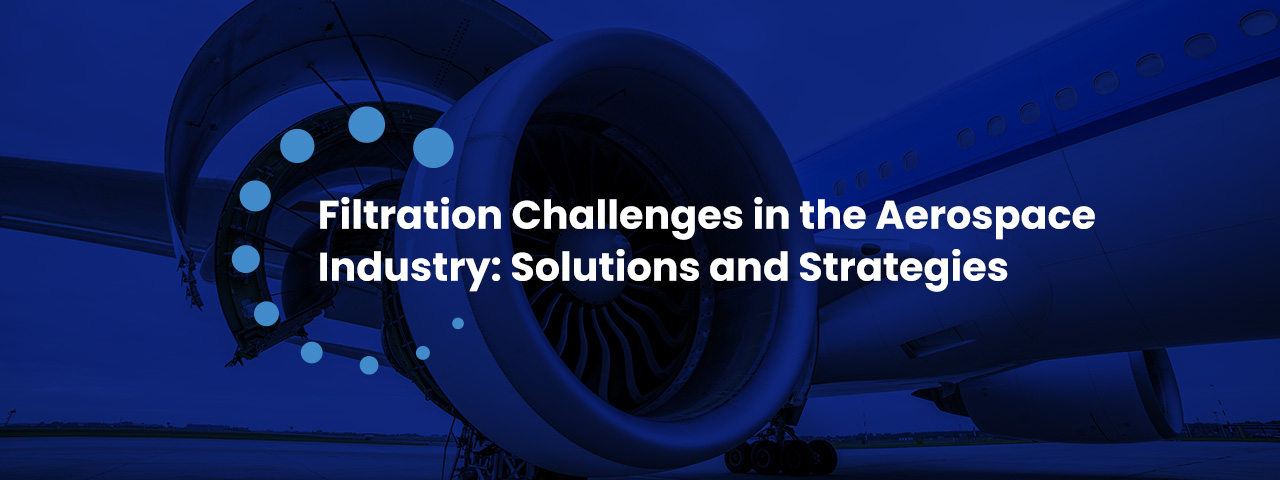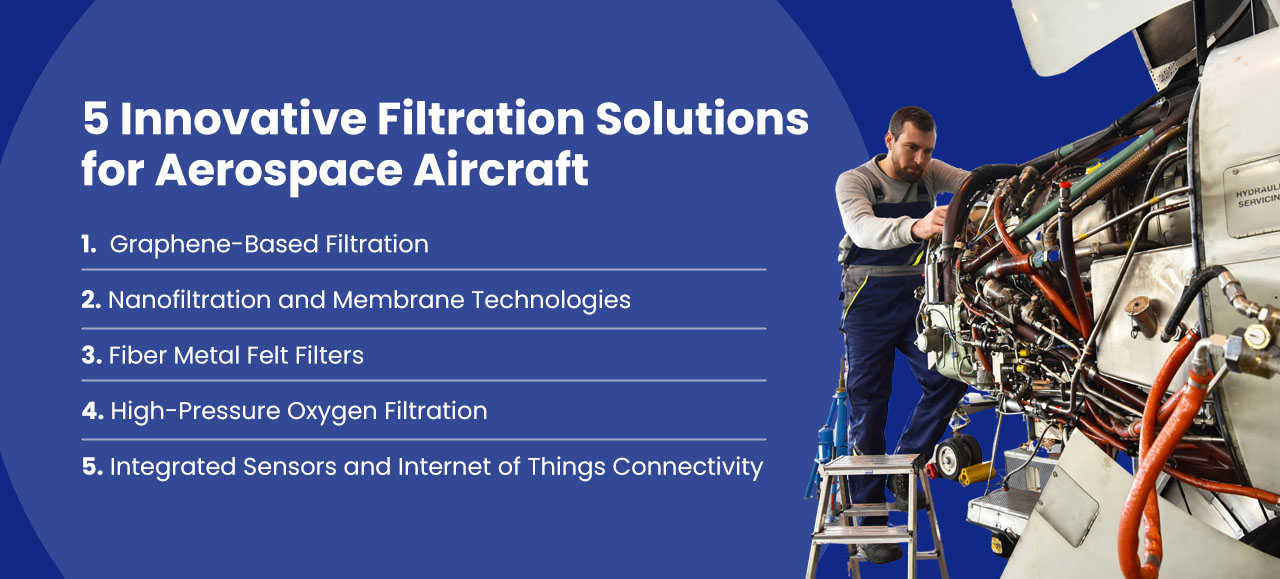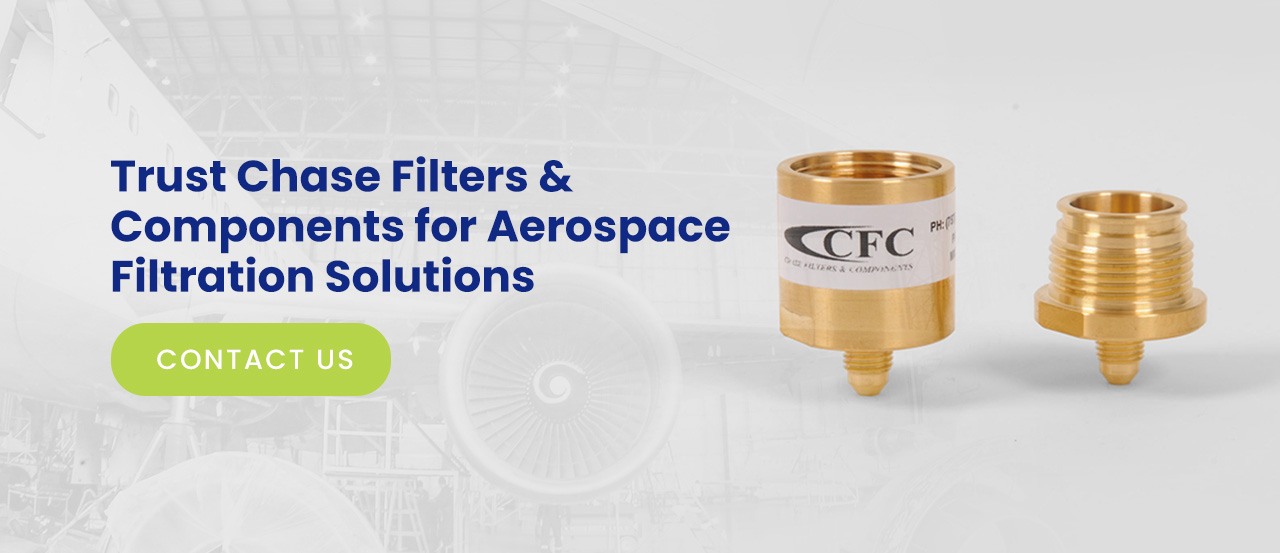October 15, 2025
Filtration Challenges in the Aerospace Industry: Solutions and Strategies

Reliable filtration systems are paramount in aerospace applications, where even the smallest contaminant can impact the safety and operational performance of aircraft. Whether it’s preventing particulates from entering fuel systems or managing airborne contaminants in cabins, high-performance filtration is important for aircraft efficiency and reliability.
This guide explores common filtration challenges in aerospace applications and industry standards. It also covers innovative solutions and strategies engineers can adopt to improve the performance of aerospace filters.
Common Filtration Challenges in Aerospace Industries
When it comes to the filtration of aerospace systems, engineers commonly encounter these issues:
Contaminant Control
Contaminants such as water, particulate matter and microbial growth are persistent threats in aerospace systems, specifically aviation fuel. Water intrusion from condensation or poor handling can lead to freezing, corrosion and microbial growth in fuel tanks.
During manufacturing, particulates such as dust and metal shavings from aluminum or titanium are combustible and may damage critical components, including hydraulic systems and engines. Regular maintenance and filter replacement are important to keep contaminants at bay and ensure long-term performance.
Aerospace Filter Clogging
Over time, particles buildup and obstruct filters, leading to increased pressure drop and reduced airflow. Since filters maintain clean air in the cabin, this decreases air quality and affects the aircraft’s system efficiency. Clogged filters raise the risk of component failure and safety hazards.
Filter Performance and Reliability
An aerospace filter must deliver consistent performance under extreme conditions and prolonged use. For example, certain aerospace filter water separators that remove particulates and water from aviation fuel are susceptible to microbial degradation. This can compromise filter integrity and contaminate the fuel system.
Another example is high-efficiency particulate air filters (HEPA), which are commonly used to maintain cabin air quality. While they capture particulates, they may be ineffective against ultrafine contaminants and volatile organic compounds.
Strict Compliance Requirements
Aerospace filtration systems must meet rigorous regulatory standards for safety, quality and reliability. This requires precision in design and manufacturing, as well as consistent and proactive maintenance practices. Noncompliance can result in operational hazards and safety violations, emphasizing the need for strict quality control systems.
Industry Standards for Aerospace Air Filtration Systems
Regulatory bodies such as the International Organization for Standardization (ISO) and the Society of Automotive Engineers (SAE) define filtration standards for aerospace systems. Below are examples of aerospace filter standards that many organizations follow:
- ISO 14085-3: Focused on aerospace fluid system filters, ISO 14085-3outlines qualification tests to evaluate filter performance. It measures separation efficiency, dirt-holding capacity, flow resistance and fatigue durability under defined operating conditions.
- ISO 16889: Designed to simulate real-world use, the ISO 16889 standard method injects contaminants continuously to assess a filter’s ability to capture particles and maintain consistent differential pressure without electrostatic interference.
- ISO 2941: This standard verifies the collapse or burst pressure rating of an aerospace filter, ensuring it can withstand specified pressure levels without structural failure.
- SAE ARP901: The SAE ARP901 standard defines bubble point testing to determine a filter’s largest pore size. It serves as a critical quality control method for verifying filter integrity.
- SAE ARP599D: Used for cleanliness evaluation, the SAE ARP599D method measures particulate released downstream after filter use or cleaning, supporting quality comparisons.
5 Innovative Filtration Solutions for Aerospace Aircraft
The following technologies have been developed to address filter reliability challenges:
1. Graphene-Based Filtration
Graphene filtration systems represent a leap forward in aerospace applications. Made from advanced aero graphene foam, this filter has an ultra-lightweight porous structure that can trap very fine contaminants even HEPA filters might miss.
Beyond superior filtration, graphene filters have self-cleaning and heatable properties. They sterilize pathogens on contact and reduce maintenance demands, extending filter life in cabins and hydraulic systems. This makes them ideal for aerospace and military environments.
2. Nanofiltration and Membrane Technologies
Nanofiltration and membrane filtration systems use fine-pored semipermeable membranes to separate contaminants at the molecular level, allowing only specific substances to pass through.
Their precision and resistance to fouling make them highly effective in managing fluids with high purity requirements for aerospace applications.
3. Fiber Metal Felt Filters
Built with sintered metal fibers, fiber metal felt (FMF) filters offer superior contaminant retention and structural integrity under dynamic environments. Their stable pore matrix resists shedding and maintains performance under vibration, heat and pressure.
FMF aerospace filters help maximize component lifespan and cut down maintenance costs in hydraulic and fuel systems.
4. High-Pressure Oxygen Filtration
High-pressure oxygen filters, such as the 25 series from Chase Filters & Components, support safe air quality and oxygen system performance. They prevent contamination-related failures, which are critical in spaceflight and life-support environments. The 25 series is also ASTM G-175 certified for proven ignition resistance.
5. Integrated Sensors and Internet of Things Connectivity
Smart filtration systems equipped with real-time Internet of Things sensors detect performance issues before failure occurs. When paired with artificial intelligence-driven analytics, they enable predictive maintenance, reducing downtime and enhancing overall system reliability.
Strategies for Overcoming Aerospace Filtration Challenges
Consider implementing these best practices to address filtration issues:
Select High-Quality Aerospace Filters
Look for filters that incorporate cutting-edge materials like nanofibers or graphene, which offer superior strength and filtration capabilities. Designs featuring pleated or multilayered structures, especially those with gradient pore sizes, can significantly enhance particle capture across various sizes while minimizing pressure drop.
Prioritize performance factors such as temperature resistance, flow rate and pressure stability for reliable filtration under demanding flight conditions. Selecting advanced, high-performance filters is essential to maintaining safe and efficient operations.
Ensure Compatibility With Aerospace Systems
Filter effectiveness also relies on their ability to function according to their intended application. Each system has distinct requirements, from hydraulic and fuel systems to oxygen supply and engine lubrication.
For example, fuel filters protect injectors and pumps by ensuring only clean fuel reaches the engine, while oil filters help extend engine life by capturing harmful particulates. Selecting filters designed for these specific applications helps maintain optimal performance and prolong component life.
Implement Filter Maintenance Best Practices
Regular maintenance is vital for preventing filtration-related failures. Begin with routine inspections to check for wear, corrosion or damage in filters, which can lead to system inefficiencies or contamination. Adhering to the manufacturer’s recommended replacement schedule is equally important, as clogged filters reduce airflow and increase energy consumption.
Lastly, invest in comprehensive training for maintenance personnel so they can confidently assess filter condition, perform timely replacements and follow safety protocols. Proper maintenance extends equipment life and supports consistent, high-performance operations.
Trust Chase Filters & Components for Aerospace Filtration Solutions
Address complex filtration challenges in aerospace applications with superior filters designed for improved performance. Consult Chase Filters & Components for cutting-edge aerospace filters that prioritize safety, efficiency and durability. We also offer custom engineering to match your requirements.
Chase Filters & Components is an industry leader in filtration with over 30 years of business expertise. We provide a range of top-grade filters for aerospace systems, such as the 31 series, 43 series and 52 series. For unique specifications, you can trust our team to design and build a custom filter that best suits your aerospace application.
Contact us today to find the best filter for your aircraft or browse our inventory for a wide selection of filter products.

